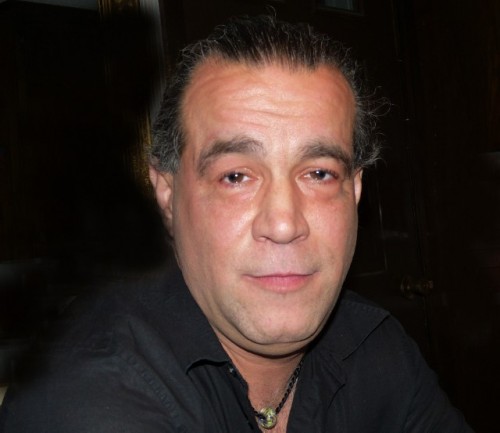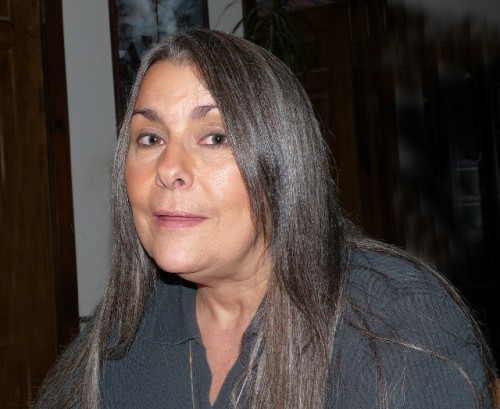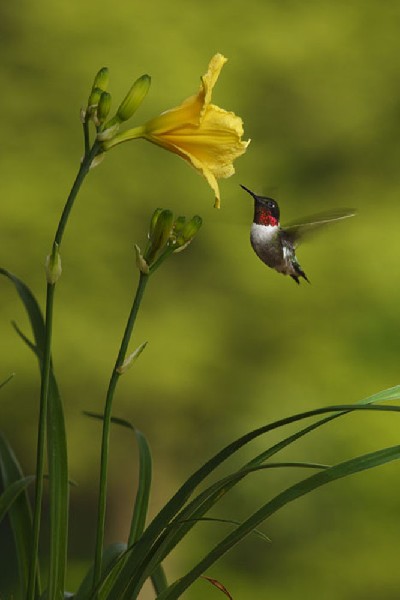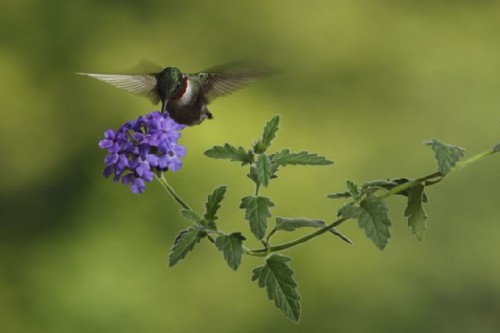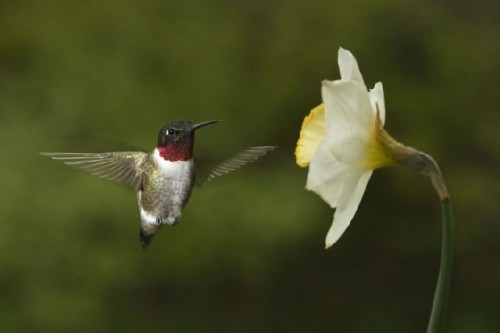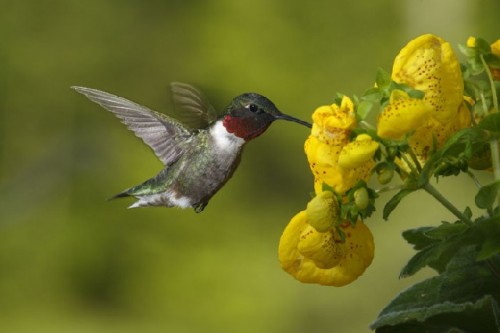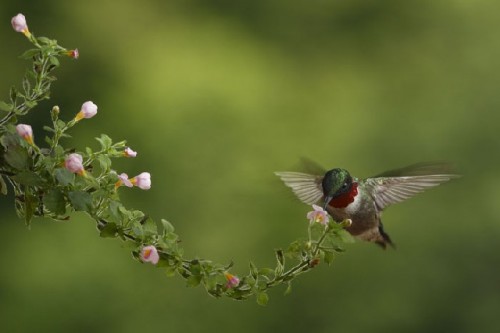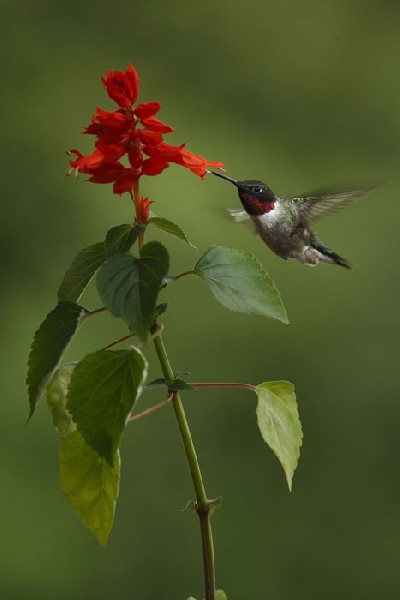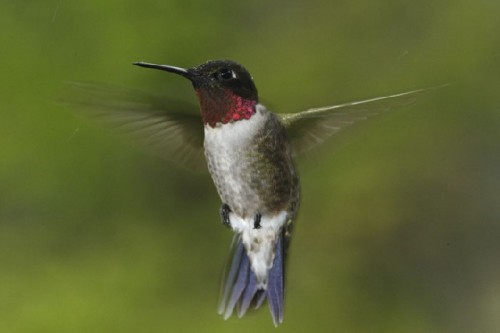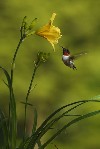Ian Grey's Hummingbirds
Berkshire Photographer Launched Project in 2005
By: Charles Giuliano - Nov 12, 2012
Hummingbird photographs by Ian Grey are currently on view, through April, at the North Adams Regional Hospital.
Following the opening Astrid and I joined Ian and Isabella Raven, a glass artist, for dinner and studio visits at their home in Florida. The wooded hamlet is located off Route Two above the Hairpin Turn that descends into North Adams.
Isabella showed us her kilns and a dedicated “torch room” with the propane tank located outside. During the winter months she prepares jewelry and glass objects that are sold at craft fairs and pow wows during the summer.
After dinner, Ian and I viewed images culled from the season’s shoot which are tweaked with Photoshop and then transferred to a large format Canon printer. He demonstrated calibrating the screen/ monitor so that the resultant print is exactly what he intends.
Through this demonstration it became clear what comprised a “portfolio” image culled from literally thousands of individual frames shot over a number of seasons from May through mid August.
Currently, he is working on relaunching a website, creating a book, planning for exhibitions, while developing a marketing and sales strategy.
Charles Giuliano How did the Hummingbirds Project come about?
Ian Grey It started when we moved here in 2005 from North Adams. Originally we were from Connecticut. We moved here to the mountain and I was sitting on the deck. There were hummingbirds on the plant hangers in the rain. There were one or two birds.
CG Had you photographed nature previously?
IG I had started just two years before. Mostly insects using extreme macro. Then I got into sports. If you combine the two- fast action sports and macro- you get a natural fit for hummingbirds. They’re small and they’re fast. My first attempts were pretty pathetic. I had a pretty bad lens and didn’t understand exposure. So I just got some dark pictures of hummingbirds sitting on plant hangers.
CG Was photography new to you or just this genre?
IG I started in 2003 and never shot film. I took advantage of the sudden proliferation of digital SLRs. Canon came out with the digital Rebel in 2003. I was one of the people who bought into it. The instant feedback taught me. By the time I got here I had a Canon 20d. I was manually focusing because the auto focus on the camera wasn’t good enough. I was using macro flash. It was this little flash that had antenna like stalks mounted onto the camera.
The images got progressively better. The pictures were very technical looking. There wasn’t much light and shadow. The bird was all lit. You could see every feather. That was nice but it wasn’t very poetic.
CG How long have you been shooting hummingbirds?
IG Eight seasons. It progresses every year. This past year I can honestly say that I achieved my vision of hummingbirds. It’s a picture of a branch coming out and a bird at the end. It’s born of the drawings that I’ve always seen of hummingbirds feeding from flowers. But I’ve never seen photographs the way that drawings were done.
(The 19th century painter Martin Johnson Heade was known for his Hummingbird series.)
CG When you’re shooting what’s the success ratio for a usable image?
IG I average about 100 shots an hour. In a ten hour day that’s about 1,000 shots a day. Usually from sunup to sundown. Isabella brings me my meals on the deck.
CG Are the birds cooperative?
IG Absolutely. They’re there every five to twenty minutes all day.
CG So you’re the St. Francis of the Berkshires.
Astrid Hiemer You must have the right hummingbird food.
IG They just love sugar water. Out of those 1,000 shots it takes on average two to three days to get a keeper. So 2,000 to 3,000 shots to get a keeper. By that I mean a frameable keeper. I get a lot that I keep. But only one or two will make it to a frame.
That one large piece at the Hospital came off the scrap heap. It was a picture I had put in a file because it wasn’t what I thought it was. It wasn’t good enough.
After a month or two of shooting I loose my objectivity because of looking at so many pictures. It becomes hard to know what’s a good picture and what’s not. I end up saving a lot of pictures and looking at them later.
You figure I took about 15,000 shots this spring. My camera shoots ten frames a second. Forty percent of that the flash can’t keep up. I’m using a Canon 1D MarkIII. I bought it used. They don’t sell them anymore. It’s old technology. It’s a 2008 camera which has been replaced. I use a 300 MM lens which focuses close.
CG Do you use a tripod?
IG Yes. What I do is create the composition. I set up the flower. We buy them from the nursery. Before I even plant it I put it on a table and set up the composition. I have the feeder there and when I’m ready.
CG Are these plants or cut flowers?
IG Both.
Isabella Raven I get to plant them after.
IG I use any flower they will go to which is almost any flower. Daffodils. The only one I know that they won’t go to is Lupine. Foxglove. Lillys. Even Calla Lillies. Tulips.
CG We’ve had some hummingbirds. Every time we see them, of course, I think of you. Can you describe where you live in the woods on the mountain and what relationship you and Isabella have to nature and the environment?
IG We live about 1,600 feet up next to a brook with a pond in the back. It affords us a lot of wild life opportunities. We see great blue herons, otters, beavers, snapping turtles, deer, bears, foxes. As far as our relationship to it we try to be as harmonious as possible.
IR We give them their space. Except the beaver. Ian and a friend of ours were throwing pebbles into the pond. Finally it took off down the bank. He figured, well, this is not a fun place to be.
IG They’re so destructive. The background of the hummingbird pictures, in the daylight, there’s a pond. Behind that is a line of trees. That’s my background. It’s about 300 feet away.
CG How do you create a relationship with the birds? They have to be aware of you. What’s the interaction like? Is there are process of getting to know them and conveying that you’re not going to hurt them.
AH Every year new birds?
IG I’m not sure. It takes a couple of weeks to get a new bird trained. To get them to understand what I want them to do. I create the composition and have to get him to go to the flower I want him to. Not just a plant but the flower. Because I’ve only got one auto focus point set on my camera. That’s the only way it can be done with hummingbirds. You can only choose one auto focus point. When you look through the view finder of a digital SLR there are all these red auto focus points. You can choose them all or one at a time.
I have the composition in my viewfinder with the plant. Then I have the flower I want them to go to. I set the auto focus point to be right at that flower. When he comes I can auto-focus on him. I don’t chase them around with a camera. I did that in 2007. It kind of works but it doesn’t really.
I had one hummingbird who was here for a long time like a month. That’s a long time before he moves on. We had a rhythm. He would come up to the deck. I would be standing next to the feeder. He would automatically go to the flowers because I was in the way. Once he had gone to the flowers and I had gotten my shots I would step away from the feeder. He would feed and go.
If he got frustrated he would land on me or my camera and wait. We had a really good relationship.
The effect of it was I couldn’t choose my background. I couldn’t choose the flower. I couldn’t choose the angle of the bird or the flower. Eventually I came up with creating the composition. Then wait for the bird. It’s much more effective.
CG Did you have a good season?
IG I had the best season ever. Seven previous seasons I had what I would call 17 portfolio worthy shots. This season I had over 20. A portfolio worthy shot is one that makes me look at it for days. When I just can’t take my eyes off it. I don’t know how to define it other than that.
The wings have to be right. That’s really important. Which is why I take so many shots. Like I said 40% of those shots the flash does not go off. I use ambient light, natural light and flash. I use them both in conjunction. That’s what renders the wings frozen with a ghost behind them. That’s the flash and natural light working together to do that. Forty percent of the time the flash does not go off because they can’t keep up with ten frames per second. So 40% I throw out right away because there’s no flash.
Out the remaining 60% the wings aren’t right in 19 out of 20 shots. So you’re down to 5% from the 60% already. From that you have out of focus shots. A bird hiding behind a flower. It just goes on and on and on.
AH What’s the perfect wing position?
IG It depends on the shot and every shot is different. To be honest with you I don’t know until I see it.
IR There’s one that’s kind of different. The one with the golden background there. I love all of them.
IG I want to tell you about Old Square Head and I have pictures of him. Basically he shut down hummingbird shooting season in a week. He shut down the whole operation in 2008 by himself.
He was very wild. I couldn’t train him. He wouldn’t allow other hummingbirds in the yard. He wouldn’t let me get a shot. After three weeks I called it quits because I just didn’t know what to do. If that had happened in 2012 I’m almost sure that would have been taken care of. As far as knowing how to train him and getting him to do what I wanted him to do.
What helped me this spring is my hummingbird blog. Even though it was a conversation mostly with myself, it was a conversation and spawned ideas. There were four hummingbirds this summer and one in particularly with like Old Square Head. Old Square Head has a square head. He was very boxy. He didn’t make for good pictures. He was just ornery. Just plain ornery. He would dive into the feeder and dive out giving me no opportunity to get a shot. He wouldn’t go to flowers.
He gave me basically nothing and I didn’t know how to take it. I didn’t know how to deal with it as someone trying to train hummingbirds.
CG Did he come back?
IG I just basically took the feeders down and called it quits.
CG Did he come back the following year?
IG No. I haven’t seen him since.
The first bird this spring knew everything I was trying to teach him before I taught it to him. So I have reason to believe that they do come back.
CG What’s the season?
IG It starts about May 5 here on the mountain a little later in the valley. It runs to mid August when they start to molt. Once they molt they look like they got hit by a bus. The feathers fall out in patches.
They fly south in early September. They winter in South America. They fly down to the Gulf. Cross the Gulf. Most cross the Gulf but some take the Peninsula. It’s 500 miles and they are in the air the whole time. Some of them are known to stop on oil rigs. But most of them fly the whole way.
They must hit feeders all the way down until they get to the Mississippi area. They just go from there and leap off.
CG What’s you ambition for this project?
IG To get as many people to see it as possible. I just opened an on line shop on ETSY.com. It’s an on line community for people who make their own products. It could be anything from art to craft and anything in between. I had a site but now I would have to do a different site. I still own the domain name IanGrey.com. Then I have my blog.
CG You said you’re beginning to sell.
IG It’s been about one a week right now. It’s been five weeks. I just started putting them out. It wasn’t until the beginning of October that I started printing and framing. Like I said I loose my objectivity and I need to put some space between me and that project.
CG During the shooting season from May through August are you out every day?
IG Most every day. I probably average a six hour day.
CG What about Isabella? Aren’t there thing to do around the house?
IR I try not to push that.
IG She gives me my space. She gives me the time to do this. She supports me. She makes my meals. She brings them to me.
IR It goes both ways. I have my own work and we give each out artistic space.
CG Now in the off season what happens. Is this when you edit?
IG Not really. The off season was when I used to shoot sports for the college (MCLA). During the school year, from September to May, it worked out. Now I’m helping Isabella with her business. I have some personal projects like the street project in North Adams. Unfortunately I have been neglecting it lately. It’s my way of helping the people who have been disenfranchised. To get their faces out there so people can’t ignore them.
CG That’s what you showed in the North Adams city council chamber?
IG Yes. Not that the city councilors in North Adams need it but what a great reminder of who they really serve. You and me can take care of ourselves for the most part. We need help every now and then but there are people who need help all the time. They need a voice because they don’t have one.
I still shoot for the Berkshire Eagle which is nice. It’s all general assignment work. From sports to city hall. It’s good for me and keeps me sharp. It gets me out there and reaching people. I’ve cut back shooting for the college.
That thing I told you about sculpting with light and shadow, that was a result of cutting back my work. It allowed me to relax.
CG Of the thousands of images that you shoot how many do you keep?
IG I go through the card and delete keeping only the images that I want on the computer. I use a card reader on the computer. Then I edit and blog. Then I do Facebook to get the word out there and let people know what I’m doing.
Even if I shoot for six hours it’s still a ten to sixteen hour day with all the editing and blogging. You start at six or seven in the morning then go till dark. Which is about seven because even on a long summer day we loose the light early because of the trees. So that right there is twelve hours.
AH All summer long?
IG No. This summer I went two months before I had to stop. Before I said that’s it I can’t do any more. Two solid months so it was 60 days. There were shots that I go eating with one hand and shooting with the other because I didn’t want to miss it. Once I set up a shot it can take a couple of days to get it to work. There’s a timing that you develop that you don’t want to interrupt. If I come into the house for an hour it breaks everything up. So I can’t come in to eat. I have to do everything out there.
CG Isabella how do you relate this this?
IR If you go upstairs you will see a mobile I did of small glass birds and I am planning to make larger ones. I am coordinating into his world. It gets him outside and into nature and not on the computer all the time. The birds are magic. Before we came up here I never even saw one.
CG Historically there are the paintings of Heade.
IG Subliminally I probably absorbed a lot of that.
CG He probably worked from taxidermy. I doubt he could sketch them in flight. Audubon shot the birds and pinned them up in order the render them. He killed everything he reproduced.
IG That was before the days of conservation. It was the norm for then.
CG Today one can hunt with a camera. It is wonderful that you can “capture” the hummingbirds while inflicting no harm on them. Through your work we come to a deeper understanding of an aspect of nature. It makes us more aware of the importance of preserving our unique Berkshire environment.

